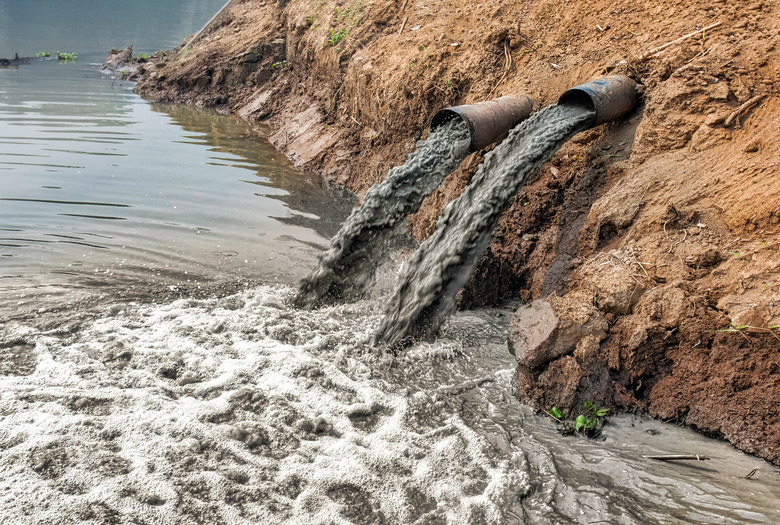List Of Water Pollutants
Water pollution occurs when untreated waste is released in to bodies of water. Polluted water can cause the destruction of plants and organisms living in or around the aquatic ecosystem. It can also harms the people, plants and animals who consume it. There are four main categories of water pollution: pathogens, inorganic compounds, organic material and macroscopic pollutants.
TL;DR (Too Long; Didn't Read)
Water pollution can be caused by pathogens, inorganic compounds, organic material and macroscopic pollutants.
Pathogens
Pathogens
Pathogens can be bacteria, protozoa or viruses. Bacteria, for example, are commonly found in water; it is when they start to increase in numbers that are above safe levels that water contamination occurs. Two of the most common pathogenic bacteria are coliform and E. coli bacteria. Coliforms are normally present in the environment in safe levels and can actually be used to detect other pathogens in water. However, if coliforms increase in number, they can be dangerous for the health of the environment. The presence of E. coli bacteria usually indicates that water has been contaminated with human or animal waste.
Inorganic Material
Inorganic Material
Inorganic materials — in particular heavy metals like arsenic, mercury, copper, chromium, zinc and barium — though harmless in very small concentrations, act as pollutants when they end up concentrated in water. This can be due to leaching from waste disposal, increased human activity or industrial accidents. This kind of water pollution, especially in higher concentrations, can cause severe health problems in humans and other organisms, up to and including death.
Organic Material
Organic Material
These materials contain molecules that have carbon in their makeup. One of the most frequently detected volatile organic chemicals is methyl tert-butyl ether (MTBE). MTBE was formerly used as an air-cleaning gas additive. Although it is now a banned chemical, it will take years before MBTE is thoroughly removed from contaminated water systems. Water contaminated with this organic chemical can cause leukemia, lymphoma and tumors in the testicles, thyroid glands and kidneys.
Macroscopic Pollutants
Macroscopic Pollutants
Macroscopic pollutants are large, visible items in waterways or bodies of water. The first common pollutant is trash: especially plastic waste. Plastic waste is often thrown directly into large bodies of water illegally, but can also end up collecting in oceans and lakes after being deposited in streams and rivers by accident. This has led to the formation of the "great Pacific garbage patch," which is now the size of France.
Other types of macroscopic pollution include nurdles (small plastic pellets), pieces of wood, metal, and even obvious things like shipwrecks and shipping containers. This form of water pollution is arguably the most manageable, however it is an urgent environmental issue that these larger pollutants be removed in order to avoid disruption of aquatic ecosystems and contamination upon the chemical breakdown of these objects.
Cite This Article
MLA
Alo, B.T.. "List Of Water Pollutants" sciencing.com, https://www.sciencing.com/list-water-pollutants-6309497/. 23 April 2018.
APA
Alo, B.T.. (2018, April 23). List Of Water Pollutants. sciencing.com. Retrieved from https://www.sciencing.com/list-water-pollutants-6309497/
Chicago
Alo, B.T.. List Of Water Pollutants last modified August 30, 2022. https://www.sciencing.com/list-water-pollutants-6309497/
